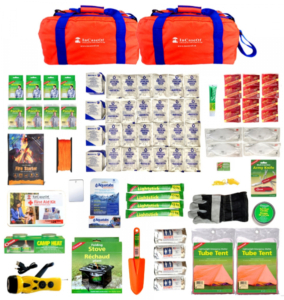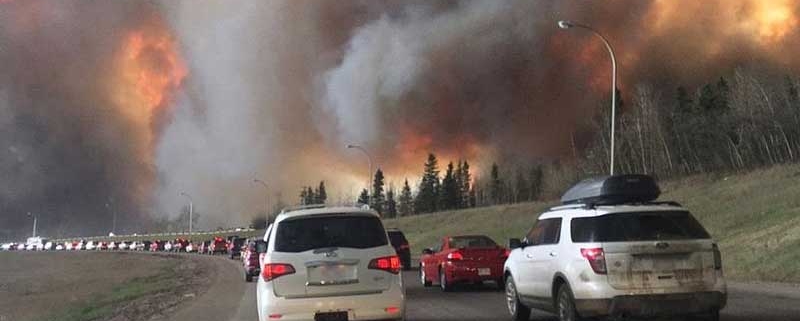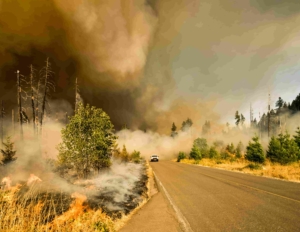Understanding Wildfires: Preparation Before, During & After
Wildfires pose a significant threat to communities and ecosystems across Canada, with devastating consequences for lives, property, and the environment. Understanding the causes of wildfires, and implementing prevention measures, are essential for mitigating their impact. In this article, we’ll explore the frequency and origins of wildfires in Canada, as well as strategies for prevention.
Frequency of Wildfires in Canada:
Canada is no stranger to wildfires, with thousands occurring each year, particularly in forested regions. According to statistics from Natural Resources Canada, an average of over 8,000 wildfires burn across the country annually, consuming approximately 2.5 million hectares of land (approx half the size of Nova Scotia). The frequency and severity of wildfires vary from year to year, influenced by factors such as weather conditions, vegetation density, and human activity.
Some helpful websites to track current wildfires, and to further educate yourself:
Canadian National Fire Database
Causes of Wildfires:
Wildfires in Canada can be sparked by various sources, both natural and human-induced. Some common causes include:
- Climate Conditions: Much of Canada is currently experiencing drought and dry seasons.
- Campfires: Improperly extinguished or unattended campfires can easily ignite surrounding vegetation, especially during dry conditions.
- Cigarettes: Discarded cigarette butts that are still lit or not fully extinguished can ignite dry grass, leaves, or other flammable materials.
- Equipment Use: Sparks or hot exhaust from equipment such as chainsaws, lawn mowers, or off-road vehicles can ignite dry vegetation.
- Arson: Deliberately set fires by individuals intending to cause damage or harm.
- Powerlines: Malfunctioning electrical equipment or downed powerlines can generate sparks that ignite nearby vegetation.
- Railways: Sparks from passing trains or malfunctioning equipment along railway tracks can ignite adjacent vegetation.
- Lightning: Natural lightning strikes during thunderstorms can ignite wildfires, particularly in forested areas with dry vegetation.
- Outdoor Burning: Burning yard waste, agricultural debris, or other materials outdoors without proper permits or precautions can lead to wildfires.
- Fireworks: Improper use of fireworks, particularly in areas with dry vegetation, can spark wildfires.
- Vehicle Accidents: Collisions or accidents involving vehicles can produce sparks or ignition sources that ignite nearby vegetation, especially if vehicles come into contact with flammable materials.
- Hazardous Activities: Activities such as welding, grinding, or cutting metal in areas with dry vegetation can generate sparks that ignite wildfires if proper precautions are not taken.

Things to Know Before A Wildfire:
An Evacuation Order means you are at risk and should evacuate the area immediately. Follow the routes specified by officials and move away from the fire as directed.
An Evacuation Alert means that you should be ready to leave on short notice, but do not yet evacuate
Learn fire safety techniques and teach them to members of your family. Discuss concepts such as:
-
-
- Stay Calm
- Assess Your Surroundings
- Seek Shelter
- Stay Low: If trapped outside, stay as low to the ground as possible to avoid smoke inhalation and heat exposure. Cover your mouth and nose with a cloth or mask to protect yourself from smoke and ash.
- Call for Help: If you have access to a phone, call emergency services (such as 911) and provide your location and situation.
- Signal for Help: If you are unable to call for help, use signaling devices such as whistles, flashlights, or brightly colored clothing to attract the attention of rescuers or nearby individuals.
- Stay Informed: Listen for updates and instructions from emergency responders or authorities via radio, television, or other communication channels.
- Stay Put (unless directed): In most cases, it is safer to stay put and wait for help to arrive rather than attempting to outrun the fire. Moving through a wildfire can be extremely dangerous and increase the risk of injury or death.
- Stay Hydrated: Drink water regularly to stay hydrated, especially if you are exposed to heat and smoke for an extended period.
-
Keep your vehicle fueled and determine two routes out of your neighborhood.
Practice your evacuation plan regularly.
If you are on a farm or ranch, leaving livestock unsheltered is preferable, or if time and personal safety permits, evacuation them from the danger zone should be considered.
Make a personalized 72 hour emergency kit.
During a Wildfire:
If you find yourself in a situation similar of needing to evacuate: grab your emergency kit(s), and follow the instructions of your local officials. Some other tips for your safety to consider:
- Be prepared to evacuate at any time. If told to evacuate, do so. If told to shelter at home, do so.
- Monitor local radio stations for up-to-date information on the fire and possible road closures.
- Park your car, positioned forward out of the driveway. Keep car windows closed and have your valuables ready to be packed in your car should you need to evacuate.
- If you do not evacuate, close all windows and doors in the house to reduce smoke and debris entering your home. Follow instructions on how to minimize fire damage.
- Move all combustibles away from the house, including firewood and lawn furniture. Move any propane barbeques into the open, away from structures.
After a Wildfire:
Conduct post-fire assessments to determine the extend of the damage. Take photos and document everything for insurance purposes. Do you not enter or return to your home if there are any visible dangers to your well being.
Utilize if needed support services and resources within your community, including assistance with rebuilding homes, restoring utilities, and addressing emotional and mental health needs in the aftermath of a wildfire.
Conclusion:
To conclude, I’d like to remind everyone once more how to actively do our part in preventing a forest fire from occurring.
- Follow Fire Restrictions: Pay attention to fire restrictions and bans issued by local authorities, especially during periods of high fire danger. Avoid outdoor activities that could potentially ignite wildfires, such as campfires, fireworks, and outdoor burning, when restrictions are in place.
- Properly Dispose of Cigarettes: Never discard cigarettes, matches, or smoking materials in forested areas or dry vegetation. Always extinguish smoking materials completely in designated receptacles or containers.
- Campfire Safety: If allowed, build campfires in designated fire rings or pits away from overhanging branches, dry grass, or other flammable materials. Keep campfires small, never leave them unattended, and fully extinguish them with water before leaving.
Pro Tip: Have a bucket of water near your fire for quick extinguishing of your campfire - Equipment Safety: Use equipment such as chainsaws, lawnmowers, and off-road vehicles with caution in forested areas. Avoid operating equipment on dry or windy days, and ensure equipment is properly maintained to prevent sparks or hot exhaust from igniting wildfires.
- Report Suspicious Activity: Report any suspicious or illegal activity, such as unauthorized burning or arson, to local authorities immediately. Early detection and intervention can help prevent wildfires from spreading and causing extensive damage.
- Practice Safe Outdoor Burning: If permitted, follow guidelines for outdoor burning and obtain necessary permits from local authorities. Monitor weather conditions and avoid burning on windy days or during periods of high fire danger.
- Educate and Raise Awareness: Raise awareness about wildfire prevention and safety within your community through educational programs, workshops, and outreach efforts. Encourage neighbors and community members to take proactive measures to prevent wildfires and promote a culture of fire safety.
- Be Prepared: Be prepared to respond quickly and effectively in the event of a wildfire. Maintain an emergency evacuation plan, assemble an emergency kit with essential supplies, and stay informed about wildfire risks and updates from local authorities.





